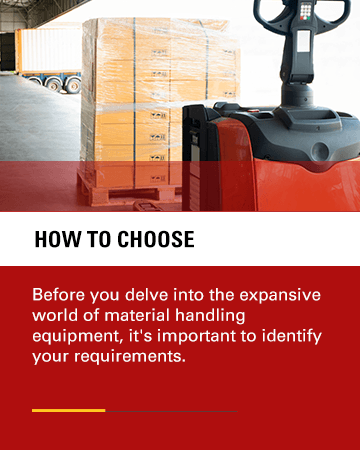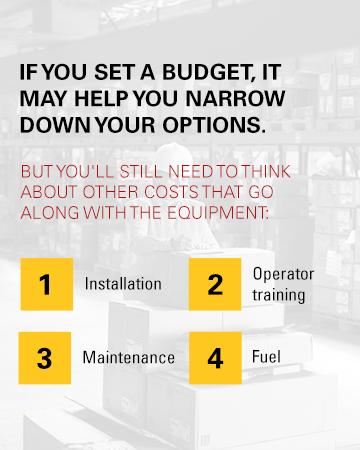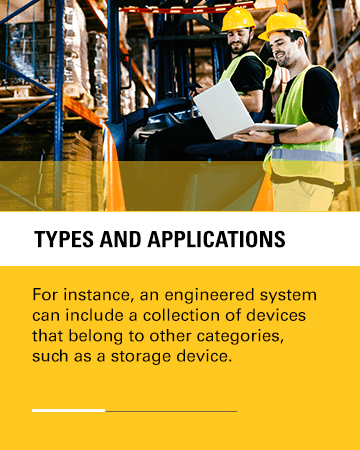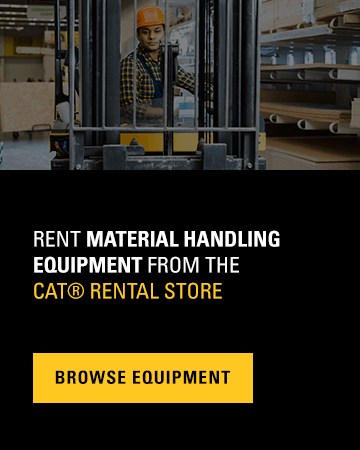
What Type of Material Handling Equipment Is Best for You?
The right material handling setup helps you move product faster, reduce risk, and keep costs predictable. This guide turns a wide category into clear choices so you can build a shortlist that fits your materials, facility, and budget. You will also see where rentals fit when you want flexibility without owning more assets.
How To Choose The Right Equipment
When considering a material handling equipment rental, start with three basics: the material, the environment, and the price. These inputs narrow options before you look at models.
1. The Material
Know exactly what you are moving and how it behaves.
- Type: Solid items, liquids, powders and flexible goods each need different tools. For bulk materials, consider particle size and flow behavior.
- Size and shape: Small, loose items call for different handling than large or awkward pieces.
- Weight: Match loads to capacity so you avoid damage and unsafe lifts.
- Unique characteristics: Volatile, perishable, or sensitive goods may require special materials or procedures.
- Packaging: Pallets, drums, or spools influence which trucks or attachments you can use without damage.
- Handling safety: Reduce manual lifts and protect workers with the right PPE and equipment choices.
2. The Environment
Confirm the machine fits the space and workflow.
- Facility limits: Verify aisle width, rack type, and ceiling height so equipment can turn and reach safely.
- Route: Straight runs, tight corners, and high picking each suggest different solutions.
- Frequency: Continuous, repetitive moves may suit automation; variable tasks may stay manual.
- Power and policies: Some spaces require electric power or specific safety features.
- Custom needs: When off‑the‑shelf options do not fit, consider engineered solutions that match your process.
3. The Price
Budget beyond the sticker price.
- Installation: Complex systems cost more to install than simple trucks.
- Operator training: Plan time for new controls and safety requirements.
- Maintenance: Every tool needs care; rentals include maintenance from The Cat® Rental Store.
- Fuel or power: Understand electricity or fuel demand for your site.
Many teams choose rentals for flexibility, lower upfront cost, and to eliminate storage and depreciation.
Types And Applications of Material Handling Equipment
Most solutions fit into four groups: industrial trucks, bulk material handling, storage and handling, and engineered systems.
Industrial Material Handling Trucks
These range from manual tools to ride‑on machines for heavier loads and higher throughput.
- Pallet trucks and hand trucks: Lift or tilt heavy boxes and palletized loads for short moves with minimal setup.
- Forklifts: Carry heavy loads at low heights in warehouses, stores, and plants. Choose mast height and tire types for your floor and racks.
- Telehandlers: Operate like forklifts with pallet forks and add reach and maneuverability for uneven terrain and outdoor yards.
- Walkie stackers and order pickers: Raise pallets or elevate the operator to reach higher locations in compact aisles.
- General material handlers: Lift and sort massive or irregular loads with claws, buckets, or grapples in plants and yards.
- Material lifts that can switch between truck types help you adapt to changing items and spaces without buying a second machine.
- Platform trucks and sideloaders: Move large, flat, or awkward items and work well in narrow aisles.
Bulk Material Handling
For loose or high‑volume materials, use dedicated storage and movement systems that stay efficient over long runs.
- Bucket elevators and grain elevators: Move product vertically for processing and storage.
- Stackers and reclaimers: Build and recover large stockpiles using rails or rotating buckets.
- Conveyors for bulk loads, including mining applications, use rugged, often troughed designs to contain material and resist wear.
- Silos and hoppers: Store and meter flow for production or loadout with better control.
- Waste handlers: Manage heavy, abrasive material with high stability and trash‑resistant features.
Storage and Handling
Organized storage boosts access and floor space efficiency across receiving, staging, and production.
- Pallets: Common wood or plastic platforms that support heavy loads up to 5,000 pounds
- Stacking frames and racks: Protect fragile items and use vertical space with drive‑in, sliding, or push‑back configurations
- Mezzanines: Modular platforms that add storage above the floor in adaptable layouts
- Shelves, bins, and drawers: Organize small or loose items for faster picking
Engineered Systems
Integrated systems automate storage and movement to improve speed and accuracy on repetitive work.
- AS/RS: Computer‑controlled shuttles retrieve items in dense storage with high accuracy and fewer touches.
- AGVs: AGVs operate autonomously along defined paths using sensors and software. Options include tuggers, pallet trucks, and fork models.
- Conveyor systems: Move items along vibrating, chain, overhead, or vertical paths to speed up repeatable steps.
Build Your Shortlist
Use this quick sequence to go from ideas to a confident decision.
- Confirm load profile: List materials, peak weights, dimensions, and packaging across a full week of work.
- Map the route: Diagram the path, turning radii, and elevation changes between storage, production, and shipping.
- Run cost scenarios: Compare installation, training, maintenance, and energy so you see total cost, not just purchase price.
- Plan safety and training: Identify PPE, required certifications, and inspection routines.
- Test fit: Pilot the top option in a critical aisle or station to validate speed, reach, and visibility.
Next Steps: Get What You Need from The Cat® Rental Store
If you prefer to rent, you can match equipment to changing workloads without long‑term costs. Rentals also simplify maintenance and storage so you can focus on throughput.
Ready to compare models and categories? Browse our selection, then reach out to us for a quick quote or scheduling support. Find The Cat Rental Store near you to connect with your local team.
FAQ
What is the main difference between forklifts and telehandlers?
Forklifts move heavy loads at low heights on smooth floors; telehandlers add reach and stability for outdoor yards and uneven ground.
When should you choose AGVs or conveyors?
Use AGVs or conveyors when routes are repeatable and volumes are consistent so automation can reduce touches and errors.
How much can standard pallets support?
Many pallets support heavy loads up to 5,000 pounds depending on construction and condition. Always confirm ratings before use.
Find The Cat Rental Store Near You



